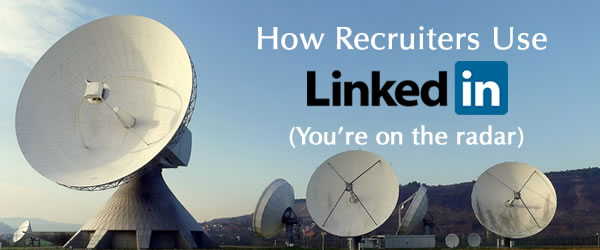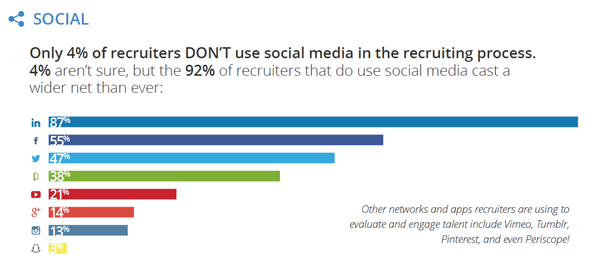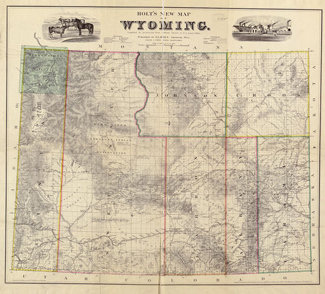
Even if you live in the wilds of Wyoming and connect to the internet with a radar dish, you’re certainly familiar with LinkedIn. The website is the 14th most popular internet destination, with 143 billion page views each year. LinkedIn is the social network for professionals. It has been in existence since 2003 and now boasts 433 million accounts in over 200 countries.
If you’re a job seeker, you’ve heard repeatedly that a well-constructed LinkedIn profile is a necessity if you intend to stay on the radar of recruiters and companies with positions to fill. There’s plenty of advice available for setting up your professional LinkedIn page – a quick Google search only produces 4,880,000 results (in .88 seconds). We’ll include a few tips at the end of this post, but skip on the opportunity to write another LinkedIn advice column.
What’s more interesting and potentially more useful to job seekers is a look at how recruiters use LinkedIn. How do recruiters use LinkedIn to find candidates? LinkedIn provides recruiters with an array of resources for hiring and your LinkedIn profile puts you in their radar range. A 2015 survey by Jobvite found that 87% of recruiters use LinkedIn as a hiring tool.

Source: Jobvite.com
“Talent Solutions,” including LinkedIn’s Recruiter (LI Recruiter) platform, are the company’s primary focus and major revenue source, producing 60% of the $255 billion that the company earned in 2015. The LinkedIn Recruiter tools provide a powerful combination of data and communications resources for executive recruiters, enabling them to conduct extensive and detailed searches of the LinkedIn database and to quickly get in touch with network members. LI Recruiter also provides a platform that allows recruiters to manage lists of candidates and to collaborate with others on their team.
How One Recruiter Uses LinkedIn
 To get a better sense of actual practice, CareerPro Global interviewed Pete Tosh, founder of The Focus Group, an executive recruiting and management consulting firm based in Macon, GA. Tosh has been a subscriber to LinkedIn Recruiter for a couple of years, and he says that the professional network has become his primary recruiting resource:
To get a better sense of actual practice, CareerPro Global interviewed Pete Tosh, founder of The Focus Group, an executive recruiting and management consulting firm based in Macon, GA. Tosh has been a subscriber to LinkedIn Recruiter for a couple of years, and he says that the professional network has become his primary recruiting resource:
LinkedIn really is far and away the best recruiting tool we’ve discovered. We post jobs on LinkedIn, but frequently we’ll start and complete a search using database access and the position is never posted. The access to information is detailed. Recruiters can search by keyword, job title, location, skill sets, and more.
LinkedIn fits our process. When The Focus Group receives a commission, we work with the employer to develop a detailed description of the opening that includes job requirements, skills needed, experience levels, certifications, and other requirements. These become the criteria for the entire recruiting process, and they provide the keywords and terms for LinkedIn search. Frequently, we’ll discover an individual who looks promising and send a message via Inmail (LinkedIn’s messaging service) to ask if they’re interested in a short conversation. Generally, people are easy to reach via LinkedIn. They pay attention to the site and they usually respond. Even if they’re not interested, they’ll ask to stay in touch, or they may refer an acquaintance who is a candidate for the position.
Candidates, not Applicants
Note that Tosh is looking for candidates, not applicants. The current job market is healthy and competition for the best candidates has increased. Jobvite’s most recent survey indicates that 69% of recruiters reported increases in hiring during 2015. 86% of recruiters don’t expect layoffs in the near future. In a tightening job market, recruiters must employ proactive methods like LinkedIn Recruiter to identify and contact the best candidates for the positions they seek to fill. Today, this can mean a reliance on research rather than more advertisement for applications.
Again, LinkedIn is a primary resource for recruiters. Tosh provides an example of how the social network provides both direct and indirect assistance:
We were searching for an attorney with a particular set of technical skills. LinkedIn identified a few candidates, but we also noticed a couple of firms in our client’s area that seemed to specialize in the area of law that our client needed. It was simple enough to check the law firm websites to identify associates who might be a fit. From there, we could return to LinkedIn for individual research and to make contact with the possible candidates we found.
While Tosh and other recruiters certainly seek out candidates that might not be actively pursuing a position, they also look for indications that LinkedIn members are open to inquiries. An active job seeker may simply state the kind of position they’re pursuing in the headline under their name. That’s an obvious signal to recruiters, but it may present difficulties with a current employer. More frequently, job seekers will add a statement of interest in the Advice for Contacting area of the Additional Information section at the bottom of the LinkedIn Profile. Including a simple statement that you are “interested in career opportunities” telegraphs your receptiveness without announcing a planned departure to your current boss.

What Recruiters Look For
While your LinkedIn profile isn’t a resume substitute, there are a lot of similarities. We asked Tosh to describe what his methods for scanning and reviewing profiles:
The LinkedIn profiles vary a lot. Some read like resumes and some are generic. If they’re too generic, I won’t waste the time. I’m usually looking for specific competencies – if the profile includes the same keywords I use in my search, it get’s priority. I’ll also give priority to profiles that clearly communicate the LinkedIn member’s goals – if they’re seeking new opportunities. They should also let me know if they want to be contacted, how to get in touch, and when.
From there, I look at work history to get a sense of their career path and advancement. As with a resume, I’m looking for gaps or problem areas. Finally, I want to get a sense of their educational background and technical skills. I really don’t pay a lot of attention to references – anyone can get a good reference for LinkedIn – or the list of LinkedIn skills.
If a contact sourced via LinkedIn expresses interest in a preliminary interview, Tosh generally requests a complete resume in preparation for the conversation. LinkedIn provides a preview, but the resume is the solid document that describes goals, capabilities, and experience.
Check Your Profile
 In the unlikely chance that you actually do live in rural Wyoming and don’t yet have a LinkedIn profile, our advice is to drive 100 miles to the nearest public library, do a Google search, and consult one of the 4,880,000 results that will help you set one up. Hopefully, you’ll find a great new position in Thermopolis, Kaycee, Rawlins, or one of your state’s other thriving communities.
In the unlikely chance that you actually do live in rural Wyoming and don’t yet have a LinkedIn profile, our advice is to drive 100 miles to the nearest public library, do a Google search, and consult one of the 4,880,000 results that will help you set one up. Hopefully, you’ll find a great new position in Thermopolis, Kaycee, Rawlins, or one of your state’s other thriving communities.
If you’re like the rest of us, here is some advice to make sure your LinkedIn profile stays on the recruiter radar screen:
-All Star Profile – a 100% complete profile includes location, detailed work history, clear job titles, and job descriptions.
-Keywords – Choose keywords that represent your capabilities, experience, and your goals. Include and repeat the keywords in headlines, the Summary Section, and in your detailed job descriptions to assure that LI Recruiter will index your profile accurately.
-Use a specific headline – Mechanical Design Engineer Robotics is certainly better than Automation Guru.
-Contact Information – If you’re open to direct contact, include all of your information in the contact info. Also, make sure to add “open to career opportunities” language and contact preferences in the Additional Info section (see above).
-Include some examples – LinkedIn provides you with the opportunity to upload files, presentations, video, and website links in several areas of your profile. Go cautiously. Adding a video resume isn’t always a great idea, but a portfolio or samples of work can provide evidence of your experience and capabilities.
Getting it All Together
If you’re considering the next step in your career, it’s probably a good time to take a close look at your LinkedIn profile and your resume. CareerPro Global can help you coordinate your efforts across media channels to present a realistic and appealing image online and on paper. Whether you’re seeking a corporate position, a federal government job or a new career after military service, the professionals at CareerPro Global will help you make a positive impression with resume and LinkedIn Profile writing services that results in interviews and career advancement. Ready to get started? Call CareerPro Global at 800-471-9201 for a free career consultation.
Sources:
Singer, Matt, Welcome to the 2015 Recruiter Nation, Formerly Known as the Social Recruiting Survey, Jobvite.com, September 2015.
Jobvite Recruiter Nation Report 2016, jobvite.com, 2016. LinkedIn Annual Report, 2015.
Images: Pixabay.com, Wikimedia.com





